One of the first comparisons I worked on at Motorcyclist was between the previous-generation Yamaha FZ1 and Kawasaki's Z1000. It was 2010 and every lover of the original FZ1 was drooling over the concept of a fresh machine from Yamaha that would use the World Championship-winning crossplane engine from the new-for-2009 YZF-R1. It didn't happen in 2010 and it's been waiting in the wings ever since. "When," we would shout at each other at the office, "is Yamaha going to just put a flat handlebar on a crossplane R1!" We waited until we lost hope. Now, it's here.
SO, WHAT'S IT LIKE TO RIDE? We can geek out on specs all day long (in fact, we did, and you can click here to read that story), but dammit what we really care about is what it feels like to twist the grip and we figure that's what you care about too. Long story short, this bike is awesome fun to ride. It's comfortable, agile, stable, and the engine absolutely cracks to life in the midrange. It seems louder than an R1—I think because it makes power earlier in the revs and it's geared shorter, so that brilliant crossplane snarl is more accessible. Stepping back, maybe the most impressive part of this bike is that when you ride it you can feel all of the little adjustments that the engineers made. It's a much more enjoyable and complete machine than it would have been if Yamaha had simply put a flat handlebar on its flagship superbike.
The suspension is noticeably softer than the R1, which will be good news for anyone who has ridden an R1 on the street. The FZ-10 didn’t give me the razor sharp feel of an R1, but it’s totally worth it for the comfort gained—and it still handles well enough to slay corners all day long and never get bored. Ergos are a big part of the comfort, too. I’ll have to wait for us to get actual measurements in our shop, but the riding position reminded me most of a KTM 1290 Super Duke R. Not as narrow in the middle as the Super Duke, but lots of legroom and a perfectly sporty reach to the handlebar.
Low pegs make for decent legroom and the tall, wide handlebar (10.1 inches higher than the R1’s clip-ons!) put me in a perfectly commanding and comfortable sport-riding position. A spacious and nearly horizontal seat gave me lots of room to move around and no notable hotspots after a full day of riding. The only ergo annoyance that struck me is that when the engine is hot it transfers a lot of heat into the frame, which is a little more exposed and available to touch than on the R1. But really, on an open-class naked bike, am I complaining? No. With power comes heat, and I’m okay with that (also it was steaming hot on both of our test days).
The best part, no surprise, is the engine. A heavier crank means it revs slower than the R1, but shorter gearing means it doesn’t feel that way. There’s loads of power on tap, enough for wheelies anywhere within the bounds of a US speed limit, and the sound is totally intoxicating. Our press ride through Deal’s Gap and the surrounding roads was perfect to test handling and maybe even better to snap the throttle open every few seconds to get a surge of power and a salvo of thunder firing out of the muffler. This bike sounds better than anything this side of an Aprilia V-4.
Three ride modes, like the FJ- and FZ-09, are designated Standard, A, and B. There is no actual change in the fueling, Yamaha explained, the mode simply changes how quickly the throttle plates open. On the FZ-10 Standard is the softest, with A as the medium setting, and B the most aggressive. I tried all three and preferred Standard—considering how much power is on tap, there’s simply no reason to rush into it with super snappy response, but it’s there if that’s what you like. Beyond the power, the FZ-10’s engine is just so buttery smooth. It purrs along in the lower third of the revs, snarls in the middle, howls up top, and does all of it on command. It will be as calm or as rambunctious as you like.
So you’ve got your superbike roots, front and center, between the crossplane powerplant and the R1-derived chassis. You might think that a simple, three-setting TC system and basic ABS system would be a major step down in performance, but it doesn’t slow the FZ-10 down. Sometimes I got a little too frisky and the TC level 2 would step in and remind me to calm down. That’s exactly why it’s there, and it never impeded fun (TC level 3 includes conservative wheelie control). Exhibit A: TC levels 1 and 2 allow wheelies while still saving slides—nifty! Yamaha has demonstrated with its FZ series of bikes that it knows how to make a motorcycle thrilling to ride, and the top-of-the-line FZ-10 is no different.
By far my least favorite part of the bike is the front brake. Revamping the R1’s system with new caliper internals, lines, and master cylinder totally took the edge off the superbike brakes. For casual riding the brakes are just enough, but when you really clamp on the lever it gets soft and feel goes away very quickly. There’s enough power to engage the ABS, eventually, but it’s not confidence inspiring. The FZ-10 is such a great package, I just wish the brakes were as good as the rest of the bike.
With every other turn in the Tail of the Dragon I realized I there were a handful of little things that hadn’t even crossed my mind, and that’s a sure sign that they’re working properly. The seat is comfortable, the mirrors don’t buzz, and the two-color dash displays all of the information (and more) that I needed, intuitively and clearly. Every whiff of this FZ-10 smells like good engineering and solid execution by a company at the top of its game. Speaking of the Dragon, take a gander at the video below to see the FZ-10 in action on the Tail of the Dragon.
HOW DOES IT COMPARE TO THE OLD FZ1? For me, this FZ-10 is treatment for an old wound. I still feel scarred from thinking that we would have a growling, crossplane FZ1 in 2010 and instead getting an updated version of the same old five-valve engine from years past with a 57-inch wheelbase, abrupt throttle response, and ho-hum handling. I remember vividly my feeling of disappointment, and I've pretty much been sad about it ever since. The new FZ-10 is everything the FZ1 should have been years ago. I'm not going to spend any more time bashing the FZ1—there are lots of happy owners, I'm sure, and it's a perfectly capable bike. To put a finer point on it, I prefer to think of the FZ-10 being better because of what Yamaha knew about creating the old FZ1. The FZ-10 is an evolution, and a good one. It's lighter, more agile, and just as comfortable—it's also much more engaging and compelling to ride.
HOW DOES IT STACK UP TO THE COMPETITION? What are you cross-shopping with the FZ-10? Ducati Monster 1200? Maybe even a Monster 821? Kawasaki Z1000, Suzuki GSX-S1000, or Honda CB1000R? To me, there are three main rivals for the FZ-10: the Aprilia Tuono 1100 RR, BMW S1000R, and KTM Super Duke R. The FZ-10 is the cheapest of that group, at $12,999, and also (almost) certainly the least powerful. It definitely qualifies to rival the best of Europe though, no doubt. In fact, I don't consider anything else that Japan has to offer as remote competition for the FZ-10. This is a modern naked, with sophistication and performance to roll with the world's best.
Just look at the styling: polarizing, to say the least. One thing I really love about the FZ-10 is that it's not trying to be anything other than its own thing. It's not going to be a vicious track weapon like the Aprilia or BMW. It's not going to match the cosmic power of that Euro trio, and in some ways will never have that semi-exotic flavor. It doesn't have a quickshifter or heated grips, either. It's not a copycat, or a "me too" model trying to ride coattails in the industry. It's a naked superbike with a heavy push toward everyday use and comfort, expected to be taken across the country and to the occasional track day. All with it's own special flavor.
THE BOTTOM LINE I saw the basic spec sheet for the FZ-10 and was worried, for Yamaha's sake, that there wasn't enough effort put into this bike. I thought it was going to be a naked R1S with wild bodywork and a good price and that would be it. The thought crossed my mind that it would be overshadowed by its little siblings, the FZ-07 and FZ-09.
To that point, I would love to have seen the FZ-10 priced at $11,500 or $12,000, but the truth is, it's worth $13K. It has genuine character, solid performance, and useful technology. More to the point, it's worthy of the R1 powerplant and worthy of the FZ moniker. The FZ-10 isn't going to set the world on fire in any one department, but this is a fun bike and it's going to make for a lot of happy owners.










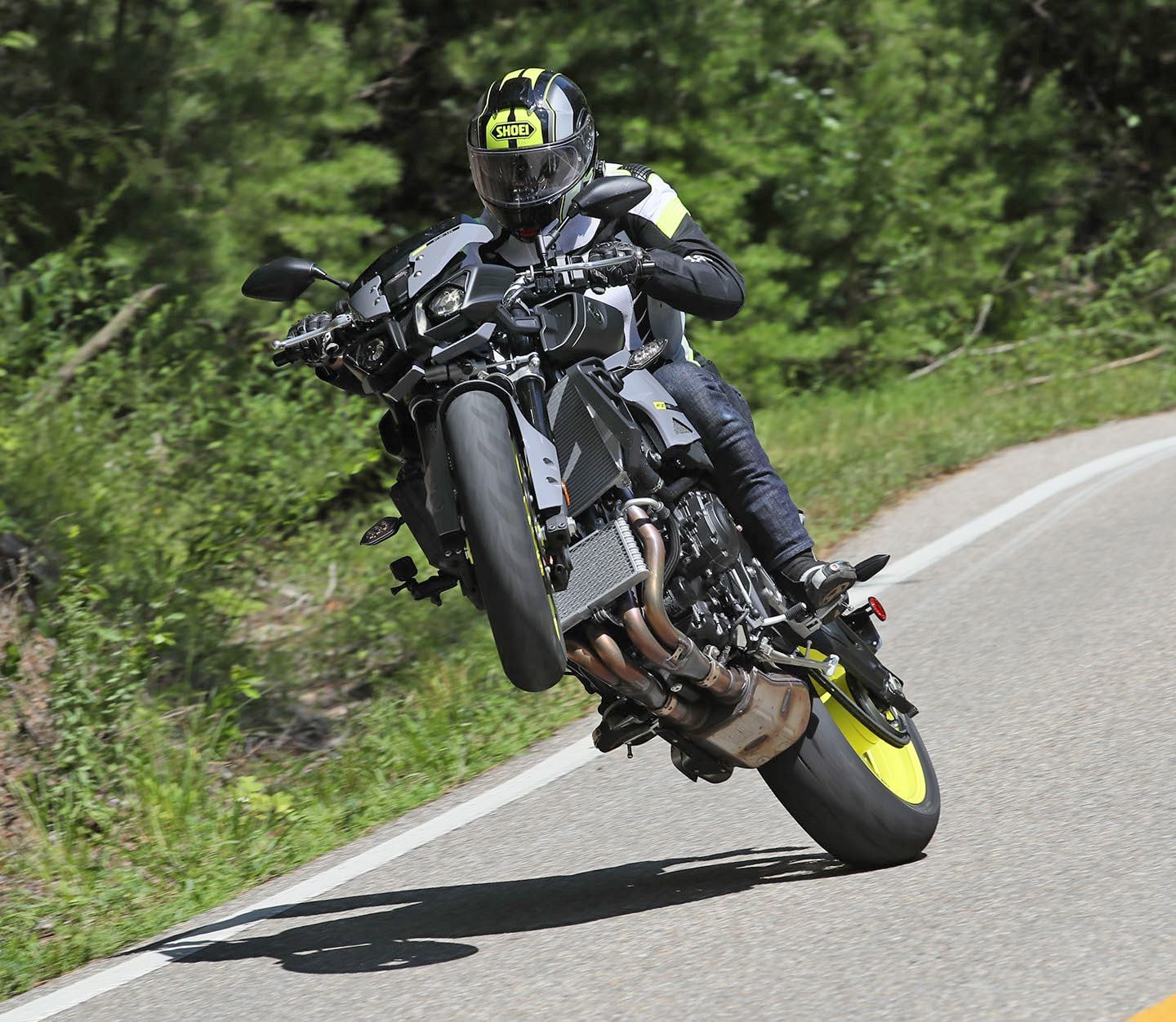


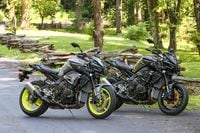
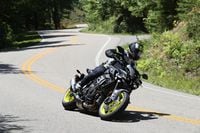
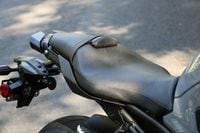
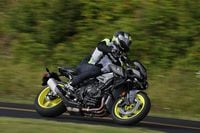
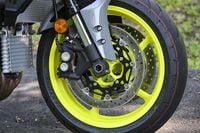

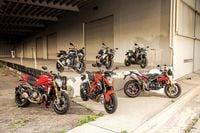

/cloudfront-us-east-1.images.arcpublishing.com/octane/S35YGSEMEZB4BLTDJTSZPF4GLA.jpg)
/cloudfront-us-east-1.images.arcpublishing.com/octane/5UOT6HPX2JFMRJAX6EH45AR4MQ.jpg)
/cloudfront-us-east-1.images.arcpublishing.com/octane/OKWOJWAKP5EP3OACCRRWPCIX2Q.jpg)
/cloudfront-us-east-1.images.arcpublishing.com/octane/2WF3SCE3NFBQXLDNJM7KMXA45E.jpg)
/cloudfront-us-east-1.images.arcpublishing.com/octane/G4MG6OUCJNBSHIS2MVVOTPX65E.jpg)
/cloudfront-us-east-1.images.arcpublishing.com/octane/IIGGWFOTOJGB7DB6DGBXCCMTDY.jpg)
/cloudfront-us-east-1.images.arcpublishing.com/octane/QSTCM6AVEZA5JJBUXNIQ3DSOF4.jpg)
/cloudfront-us-east-1.images.arcpublishing.com/octane/U4I7G625B5DMLF2DVIJDFZVV6M.jpg)
/cloudfront-us-east-1.images.arcpublishing.com/octane/B6XD6LS6IVCQPIU6HXDJSM3FHY.jpg)
/cloudfront-us-east-1.images.arcpublishing.com/octane/ICL63FEDDRDTTMINYICCEYGMDA.jpg)
/cloudfront-us-east-1.images.arcpublishing.com/octane/FCGZHQXRBZFLBAPC5SDIQLVF4I.jpg)
/cloudfront-us-east-1.images.arcpublishing.com/octane/WNOB6LDOIFFHJKPSVIWDYUGOPM.jpg)

/cloudfront-us-east-1.images.arcpublishing.com/octane/X33NU3E525ECRHXLNUJN2FTRKI.jpg)
/cloudfront-us-east-1.images.arcpublishing.com/octane/6KKT5NNL2JAVBOXMZYS5ZO76YA.jpg)
/cloudfront-us-east-1.images.arcpublishing.com/octane/J5RKG5O455GMPGQRF2OG6LRT7A.jpg)
/cloudfront-us-east-1.images.arcpublishing.com/octane/GX2CIZKQVRH2TATDM26KFG2DAE.jpg)
/cloudfront-us-east-1.images.arcpublishing.com/octane/ZWIDYSAKQZHD5BHREMQILXJCGM.jpg)
/cloudfront-us-east-1.images.arcpublishing.com/octane/CYUHJZCTSJCH3MRAQEIKXK7SCQ.jpg)
/cloudfront-us-east-1.images.arcpublishing.com/octane/LKOFINY56FCXJCANJ5M7ZDQUBY.jpg)
/cloudfront-us-east-1.images.arcpublishing.com/octane/4NBPDACMWJH63JQYJVK3QRBDZI.jpg)
/cloudfront-us-east-1.images.arcpublishing.com/octane/KKHQHRR3FJGX7H2IPU6RALMWG4.jpg)

/cloudfront-us-east-1.images.arcpublishing.com/octane/5IOFS5JAE5FOXMNA23ZRAVVYUU.jpg)